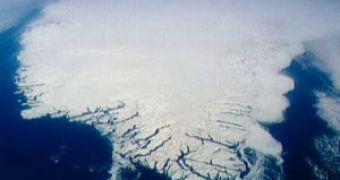Using a new satellite technique that measures the changes in the weight of the ice sheet, NASA scientists showed that ice losses now surpass ice gains in Greenland's ice sheet.
Greenland's low coastal regions have lost 155 gigatons (41 cubic miles) of ice per year between 2003 and 2005, increased melting and icebergs, while the high-elevation interior gained 54 gigatons (14 cubic miles) per year from excessive snowfall. "With this new analysis we observe dramatic ice mass losses concentrated in the low-elevation coastal regions, with nearly half of the loss coming from southeast Greenland," said Scott Luthcke of NASA Goddard's Planetary Geodynamics Laboratory.
"In the 1990's the ice was very close to balance with gains at about the same level as losses. That situation has now changed significantly, with an annual net loss of ice equal to nearly six years of average water flow from the Colorado River."
The study is based on an innovative use of data from the Gravity Recovery and Climate Experiment (GRACE) satellite that reveals detailed information about where and when the Greenland ice mass has changed. In the new study, the scientists searched in detail how change is distributed among the different zones of the Greenland's ice sheet.
The ice sheet was divided in six "drainage systems", according to the directions that the ice sheet flows from the center of the island toward the coasts, with high- and low-elevation areas. The ice amount remained greatly unchanged in the two northernmost parts, while ice was lost in the greatest amount along the southeastern coast.
The satellites measured changes in Earth's mass bellow them and the team used a more local and frequent view, only from over the Greenland region, at a smaller-scale mass change readings every 10 days.
Thus, the scientists could monitor the ice sheet piece by piece and all year round and compare what they found to previous data. "With this new detailed view of the Greenland ice sheet, we have come a long way toward resolving the differences among recent observations and what we know about how the ice sheet behaves," said Waleed Abdalati, head of Goddard's Cryospheric Sciences Branch.
"The seasonal cycle of increased mass loss during the summer melt season and growth during winter is clearly captured," said Jay Zwally, ICESat project scientist.
The massive ice losses occurred in the same drainage systems where previous studies reported increased glacier flow and ice-quakes in the ice shelf. The new data coincide with earlier reports based on radar measurements of glacier acceleration. The losses measured by the new study are less than 50 % of other observations, but even so, Greenland is losing 20% more ice than it is deposed from snowfall annually. "This is a very large change in a very short time," said Zwally.
"In the 1990's, the ice sheet was growing inland and shrinking significantly at the edges, which is what climate models predicted as a result of global warming. Now the processes of mass loss are clearly beginning to dominate the inland growth, and we are only in the early stages of the climate warming predicted for this century."
The team is going to study individual drainage systems in Antarctica.

 14 DAY TRIAL //
14 DAY TRIAL //